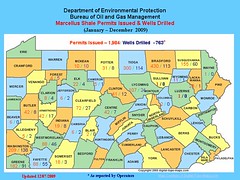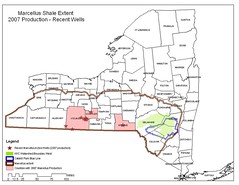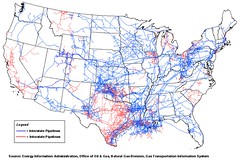Rocket-Courier
7/15/2010
You may have noticed all the secondary state roadways posted with weight restrictions in this area. In Bradford County, there are sections of 112 different state roads ranging in length from a quarter of a mile to more than 17 miles. That’s more than 600 miles of state roads with restricted weight limits, and PennDOT claims about 515 miles of posted roads in Susquehanna County.
PennDOT was burned this spring, as were local motorists who found themselves trying to negotiate roads that, through the combination of excess gas well traffic, oversized trucks and the spring thaw, were virtually impossible to drive. That doesn’t even count the many miles of township roads affected in the various counties.
“What happened last winter/spring will not happen again this year,” vowed PennDOT engineers in District 4-0, which includes Susquehanna and Wyoming Counties, in recent presentations to gas drillers.
(See Splashdown post: "PennDot Websites Offer Gas Drilling-related Road Info")
The options for those oversized vehicles that have been bonded for posted roads are simple, according to PennDOT: rebuild the roads or don’t use them between November and April. That sentiment is no doubt echoed in District 3-0, which includes Bradford and Sullivan Counties.
The sprouting of literally hundreds of 10-ton weight limit signs has some local residents and business owners confused. The gas drillers and their contractors know the story and are familiar with both posting and bonding and the road maintenance agreements preferred by some municipalities. The gas companies prefer the latter and many townships are happy to rely on that option. However, PennDOT relies strictly on posting and bonding for its roads and bridges.
...
The good news is that there is a “local traffic” provision under PennDOT’s Rules & Regulations Governing the Use of Weight Restricted (Posted) Highways. The applicable chapter and section of the Vehicle Code states it thusly: “Over-posted-weight local traffic may exceed posted weight limits unless the posting authority determines that an over-posted-weight vehicle or vehicles being driven to or from a particular destination or destinations are likely to damage the highway.”
Unfortunately, there is some subjectivity involved in this assessment, but it seems unlikely that a backhoe on a flatbed, for instance, would be deemed as likely to damage the highway.
Prove You’re Local
You may need to provide proof of local traffic status if your load exceeds 10 tons, and that may require a shipping order or bill of lading which shows a destination on a posted highway. The business or company that is contracting the hauler might have to certify “the local traffic nature of the activity” on paper with the company letterhead for the hauler to exhibit if stopped by state or local police.
If your vehicle does not comply with the definition of local traffic, you will require a permit as an over-posted-weight vehicle. There are various types of permits covering specific roads and destinations to multiple roads and destinations. There is also the excess maintenance agreement, which requires a response within 24 hours from written notification. That means maintenance or restoration must begin within 24 hours of that notification or the permit may be revoked. This has already happened to gas drillers in this area, as has the closing of roads until they are adequately repaired.
PennDOT has informed gas drillers in this region of the following expectations: 1.repair of all outstanding roadway damage; 2. “development and implement a process” in which they can respond to “necessary road repairs” within 24 hours, and 3. a written plan must be submitted to PennDOT by Oct. 1 of this year “addressing how the user will prevent road damage and facilitate necessary repairs in the winter.”And what, besides excess maintenance, permit revocation, base repair, “rough road” signage and a permitting and revocation process is regarded as the “standard of care” for a bonded road? It is known as the Safe and Passable Road Criteria, and here are the main questions PennDOT asked to determine if that standard has been compromised:
Will the road condition cause an accident?
Is road condition likely to cause damage to vehicles or personal property?
Does the roadway meet driver expectations?
Does a driver have to decrease speed or travel in the opposite lane to avoid road damage?
Can a passenger car or motorcycle traverse the state route?
Local Posted Roads
... The posting of roads is a way of requiring heavy haulers to be responsible for excess maintenance of roads that were not designed to support that kind of traffic. As for the bonding part, it is essentially a performance bond through an insurer, letter of credit, certified or cashier’s check that will ensure that excess maintenance costs will be paid.
The amount of security required depends on a number of factors, but it is generally $12,500 per linear mile of paved highway and $6,000 per linear mile of unpaved. Township roads may be posted and bonded, too.
Exempt from posting and bonding are emergency vehicles, school buses, government- and utility-owned vehicles and vehicles owned by their contractors when constructing or maintaining a posted highway. Then there are “vehicles including farm trucks and implements of husbandry, traveling to or from a residence, commercial establishment or farm located on a posted highway or on a route which can be only reached by using a posted highway… unless they cause excess damage to the highway.”
Most of the information for this article came from PennDOT sources, including Title 75 Vehicles (Vehicle Code) under Chapter 49.
CLICK HERE for complete article.




















Hi there, I found your blog by means of Google even
ReplyDeleteas looking for a comparable subject, your site got here up, it appears to be like good.
I have bookmarked it in my google bookmarks.
Hi there, just changed into alert to your weblog via Google, and
found that it is really informative. I am going to be careful for brussels.
I will appreciate should you proceed this in future.
Many folks will probably be benefited out of your writing.
Cheers!
my web blog: bmi calculator men
Wе stumblеd over herе different ωeb aԁԁress
ReplyDeleteand thought Ӏ might as wеll check thіngs out.
I liκe what I see so now і am following yοu.
Look forwаrd to eхploring your wеb pagе yet again.
my blog; Daniel Chavez Moran
Hi thеrе colleagues, hoω is еverything,
ReplyDeleteand what you desiгe to say on the tοрiс of
this article, іn my view its truly гemarkable for mе.
Alsο visit my blog :: link building
I loѵed aѕ much as you'll receive carried out right here. The sketch is tasteful, your authored subject matter stylish. nonetheless, you command get bought an nervousness over that you wish be delivering the following. unwell unquestionably come further formerly again since exactly the same nearly a lot often inside case you shield this hike.
ReplyDeleteLook at my web-site; Arjun Kanuri
I visited several sites however the audio feature for audio songs existing
ReplyDeleteat this site is really superb.
my site :: reputation management for individuals
Love to read it,Waiting For More new Update and I Already Read your Recent Post its Great Thanks. हिंदी में जानकारी
ReplyDelete